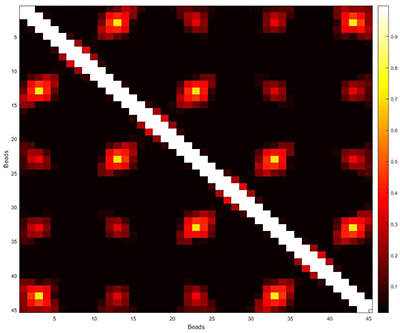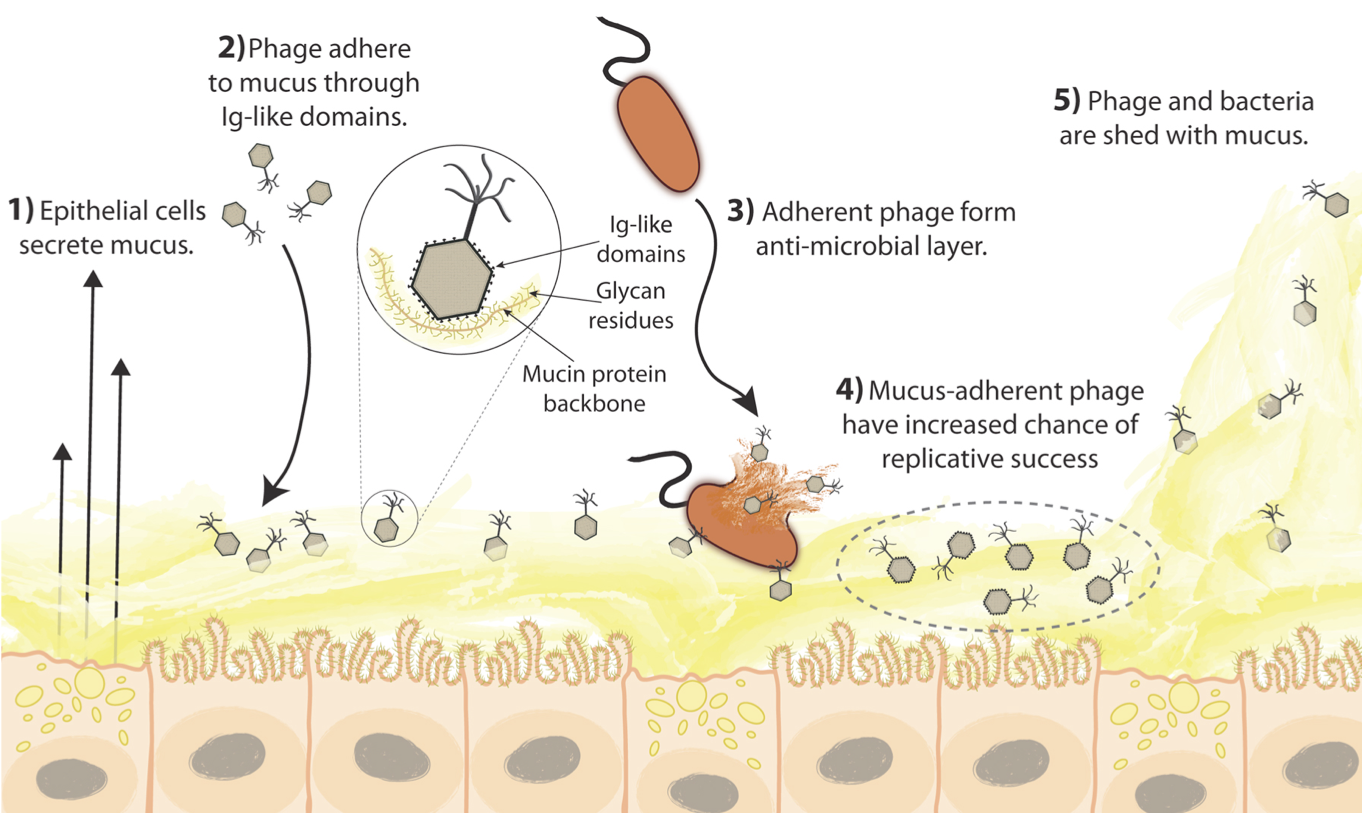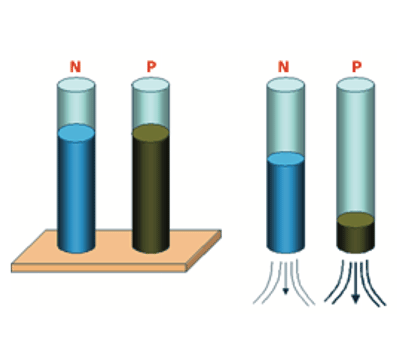Research Summary
Several systems such as granular materials, colloidal suspensions, polymeric liquids, and biological matter, are classified as complex fluids because their microstructure crucially influences their material properties. These systems are inspiring several new technologies. A key challenge is to describe their flow behaviour by understanding the connections between their microscopic structure and macroscopic properties. The molecular rheology group uses molecular models and a continuum level description to advance the microscopic and macroscopic description of polymer solution dynamics.
In the 21st Century, the most significant advances in biomedicine will emerge from the interface between the biomedical and physical sciences. Key to this initiative is cross-disciplinary research that addresses important human health issues with novel and innovative approaches informed by advances in the physical sciences. Recent research in the molecular rheology group is aimed at building better models with general applicability to understand a number of important problems in biology and biomedicine.
Interests
- Sticky Polymers in Flow
- Dynamics of Chromatin Folding
- Internal Friction in Polymer dynamics
- Monitoring Drug Binding in Cells
- Modelling Bacteriophage Motion
Molecular Rheology Group Members
Amit Varakhedkar
Ph.D. student
Amit Varakhedkar received a Bachelor's degree in Mechanical Engineering from the SRM Institute of Science and Technology Chennai in 2020. He is a student at the IITB-Monash Research Academy, where he is co-supervised by Professor P. Sunthar. His Ph.D. is on "Understanding the physical response of cells to force by simulating the mechanics of sticky biopolymer networks".
Avishek Kumar
Ph.D. student
Avishek Kumar graduated from the Indian Institure of Technology Gandhinagar in 2019 with an MTech degree in Chemical Engineering. He is a student at the IITB-Monash Research Academy, where he is co-supervised by Professor P. Sunthar at the Academy and by Professor Rico Tabor at Monash University. His Ph.D. is on "Modelling dynamics and flow for soft fibre systems".
Amit Varakhedkar
Ph.D. student
Amit Varakhedkar received a Bachelor's degree in Mechanical Engineering from the SRM Institute of Science and Technology Chennai in 2020. He is a student at the IITB-Monash Research Academy, where he is co-supervised by Professor P. Sunthar. His Ph.D. is on "Understanding the physical response of cells to force by simulating the mechanics of sticky biopolymer networks".
Avishek Kumar
Ph.D. student
Avishek Kumar graduated from the Indian Institure of Technology Gandhinagar in 2019 with an MTech degree in Chemical Engineering. He is a student at the IITB-Monash Research Academy, where he is co-supervised by Professor P. Sunthar at the Academy and by Professor Rico Tabor at Monash University. His Ph.D. is on "Modelling dynamics and flow for soft fibre systems".
Join the group!
We are looking for people who are outstanding, and highly motivated with a background in a field related to our research interests. Monash University offers scholarships to cover fees and living expenses to highly qualified students applying for a Ph.D. Interested students in India can also apply to the IITB-Monash Research Academy, which offers scholarships to talented students. Ph.D. students in this program receive a dual-badged degree from IIT Bombay and Monash University.
Research Projects
-

Several disparate phenomena, such as: (i) the flow behaviour of paints, coatings and inks, (ii) the treatment of diseases in the posterior segment of the eye, (iii) the development of food thickeners for people suffering from mastication and swallowing disorders, (iv) the designing of scaffolds with optimal characteristics for successful tissue engineering, and (v) the response of hagfish when attacked by predators, have all got one feature in common – they are based on the unique properties of supramolecular networks formed by associative (sticky) polymer solutions. Associative polymers are macromolecules with attractive groups, and the reason for their use in such a wide variety of applications is because the interactions between the attractive groups can be “tuned” by varying their number, strength and location on the polymer. This provides a means of exquisitely controlling the physical properties of associative polymer solutions. Currently, successful formulation of the appropriate associative polymer system for these various applications has rested on using polymer chemistry to engineer innovative polymers, followed by extensive experimental investigation to select the most suitable candidates. It is not possible at the moment to start with the desired application in mind, and then specify the particular macromolecular architecture, the precise number, strength and location of the attractive groups, and the appropriate solution temperature and concentration, that would achieve the most optimal product performance. The aim of this Monash/MIT collaboration is to make significant progress towards achieving this goal. An integrated theoretical and experimental approach will be developed to determine how microscopic topology and the strength/number of intermolecular interactions control the flow behaviour of model associative polymer solutions. In particular, Brownian dynamics algorithms will be developed at Monash to unravel the complex dynamics of the network and calibrated by comparison with carefully designed experiments in MIT. The expected outcome is a quantitative framework for connecting the molecular structure and energy landscape with resulting macroscopic properties. This should yield significant benefit in the rational design of supramolecular systems in which the thermorheological properties can be tuned over a wide range of force/time scales with applications spanning from enhanced oil recovery to injectable hydrogels.
-

The fate of a cell is decided by the “state” of its chromatin. Chromatin is a packaged form of DNA – a long polymer that carries genetic information. In humans, the total contour length of DNA is approximately two meters, 10000 times larger than the dimensions of the cell nucleus. The packaging of chromatin in the cell is achieved with a large number of proteins that bend and fold DNA to induce local curvature. The precise structure of the packaged chromatin is still an open question. In order for life processes to go on, chromatin needs to be unfolded and refolded dynamically so that it can be read, repaired and replicated repeatedly. Nearly nothing is known about how the unfolding and folding happens, and the precise sequence of events during folding and unfolding. Understanding and defining the different states of chromatin is a huge task. Some of the major deciding factors are the arrangement and distribution of proteins along the DNA, and the influence of their binding and dissociation dynamics on the transient 3D architecture of the compacted DNA. Existing experiments provide information on contact probabilities between different parts of the chromatin, averaged over many cells. They are consequently only frozen snapshots of protein positioning and 3D DNA architecture. A proper understanding of cellular processes requires the development of a dynamic model that can predict how chromatin is locally folded and unfolded regularly, within the timescale relevant to biological processes such as transcription and gene regulation. The aim of this project is to develop a multi-scale model that can predict the dynamics of chromatin packaging on the scale of many genes. Brownian dynamics simulations based methodologies will be used to understand how local structures and elements such as protein density and positioning dictate the dynamics of chromatin folding. We also aim to learn how the curvature created by proteins on the DNA, and interactions between proteins and DNA determine the rate of folding and the nature of local folded structures, which are fundamental to determining transcription-factor accessibility and gene regulation.
-

The influence of internal friction on the rheological response of polymer solutions has been studied from the inception of the development of coarse-grained kinetic theory models for polymer dynamics. The inclusion of a resistive force proportional to the rate of change of the connector vector between beads leads to a shear-rate dependent viscosity, a finite limiting value for the infinite frequency limit of the dynamic viscosity, and to instantaneous stress jumps at the inception of steady shear flow. More recently, experimental, and theoretical studies have shown that the presence of internal friction modulates conformational changes in a number of different biological contexts. This includes slowing down the process of protein folding, influencing stretching transitions in single biomolecule force spectroscopy, and effecting the dynamics of intermolecular interactions in intrinsically disordered proteins. In all these situations, internal friction arises from configurational rearrangements of biomolecules on an underlying energy landscape. In parallel, recent advances in modelling polymer solution rheology has revealed the crucial role played by fluctuating hydrodynamic interactions in determining the dynamics of polymers. Models that include both internal friction and hydrodynamic interactions are rare. In this work, Brownian dynamics simulations will be used to carefully differentiate the influence of solvent-mediated friction on conformational dynamics, from the influence of a dissipative mechanism that is independent of solvent viscosity. Understanding the molecular origin of internal friction is key to understanding aspects of protein folding, the dynamics of intrinsically disordered proteins, and the transient response of polymer solutions subjected to a variety of flow fields.
-

There is an impending crisis in the practice of medicine. The treatment of routine infections may no longer be possible because of increasing prevalence of drug resistant bacteria. Drug discovery is a major focus of current research to deal with antimicrobial resistance (AMR), but an equally important challenge is to develop new analytical methodologies to screen potential drugs against cellular targets. Many targets for AMR drugs are high aspect ratio complex molecular assemblies of proteins, lipids, and nucleic acids, which are challenging to characterise using traditional techniques such as NMR or X-ray crystallography. Linear dichroism (LD), however, is a powerful technique to analyse the structure of filamentous assemblies and long molecules. Nevertheless, only a qualitative indication of drug binding can currently be deduced from LD. Using a multidisciplinary approach combining mesoscopic Brownian dynamics simulations with single molecule fluorescence microscopy and flow oriented spectroscopy, we aim to extract the maximum level of dynamic structural binding information from LD spectra, so it can serve as a quantitative screen of drug binding to molecular targets in bacteria.
-

Mucosal surfaces are the primary zones where animals meet their environment, and thus also the main points of entry for pathogenic microorganisms. Within mucus, the predominant macromolecules are large mucin glycoproteins. The biophysical and biochemical properties of individual mucin chains determine the gel properties of the mucus layer. Recent research in Dr Jeremy Barr’s group at the School of Biological Sciences in Monash, has demonstrated that bacteriophages – viruses that infect and kill bacteria – adhere to mucosal surfaces. The adherence was characterised with high-speed microscopy and particle tracking, and it was demonstrated that mucus-adherent phages exhibit subdiffusive motion in mucin solutions, which enhanced their encounter rates with bacterial hosts, providing increased antimicrobial affects and protection against bacterial infection and disease. The 3D organisation of the mucin network and phage adherence to mucus results in a complex biophysical process that leads to subdiffusive motion of the phage particles. Yet the subdiffusive mechanism remains unknown. The aim of this project, which is being carried out in collaboration with Jeremy Barr in Monash and Sunthar in IIT Bombay, is to simulate a mucus environment and the interactions of mucus-adherent and non-adherent phages with the mucus network. How these adherence mechanism results in subdiffusive motion and how this motion increases the phages antimicrobial affects is an interesting and yet to be solved problem that has important implications for fundamental biology and biotechnology applications.
-

The use of polymer solutions in the intermediate stages of various modern processes makes the understanding of the dynamics of polymer solutions essential for maximising the efficiency of these processes. Small amounts of polymer are known to reduce the drag experienced by bodies in turbulent flows, and significantly change the distribution of drop sizes in spraying and atomisation operations. There are also a number of contexts involving polymer solutions, such as in the spinning of nanofibres or in ink jet printing, where in order to achieve the most optimal outcome, the concentration of polymers must not be too dilute or too concentrated, but somewhere in between. It is vitally important to unravel the fundamental physics that governs the behaviour of polymer solutions across the range of concentrations in the presence of a flow field.
In this project, the dynamics of polymer solutions will be investigated through theory, computer simulations and experimental characterization, using a novel computational algorithm and the filament stretching rheometer. The experiments will provide an understanding of the linear and non-linear viscoelastic behaviour of polymer solutions, spanning a range of concentrations and molecular weights, which will allow a unique and unrivalled detailed study of these systems. The correlation of molecular simulations with rheology measurements will enable a much clearer understanding of the connection between microscopic physical mechanisms and macroscopic flow properties.
-

A wide variety of activities in the living cell are crucially dependent on the mechanical properties of biopolymers. The dynamics of biopolymers are also relevant in the efficient design of microfluidic and micro-fabricated devices, which require a thorough understanding of the behaviour of biopolymers under the action of imposed flow fields. Understanding the response of biological macromolecules to stress is therefore fundamental to understanding a variety of biological processes and laboratory-on-a-chip devices. A major revolution in the pursuit of these studies has occurred in the last decade due to the development of optical and mechanical probes that are sensitive enough to make measurements on single biomolecules, and consequently give totally new insights into the structure and dynamics of living matter at nanometer scales. The new mechanical tools enable the application of forces that are large enough to induce structural deformation, and consequently probe the three-dimensional structure of the molecules. The parallel development of single molecule detection and single molecule spectroscopy by laser-induced fluorescence has enabled insight into the conformational states and conformational dynamics and activities of single biomolecules. Instead of previous experimental methods that relied on inferences drawn from ensembles of molecules, the new techniques allow one to answer questions about the behaviour of individual molecules.
The centrality of deformation in this new paradigm in molecular biology enables us to draw an analogy with developments in the molecular rheology of polymer solutions, which can be fruitfully exploited to significantly augment the study of biomacromolecules. The goal of our research is to carry out interdisciplinary research in which the techniques of experimental and theoretical rheology, and advances in single molecule techniques, are brought to bear on several physical problems that are relevant in a biological context.

